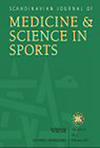Prevalence of Chronic Traumatic Encephalopathy in Athletes With Repetitive Head Impacts: A Systematic Review and Meta‐Analysis
IF 3.5
2区 医学
Q1 SPORT SCIENCES
引用次数: 0
Abstract
Chronic traumatic encephalopathy (CTE) is a neurodegenerative disorder associated with repetitive head impacts (RHI), which is commonly observed in athletes participating in contact sports. This systematic review and meta‐analysis aimed to provide a clearer elucidation of the prevalence, risk factors, and potential outcomes of CTE in athletes. Through a comprehensive search of PubMed, EMBASE, Web of Science, and Google Scholar (January 2015 to July 2024), we ultimately included eight eligible studies with a low risk of bias involving 1000 former contact sports athletes diagnosed by neuropathological methods. Data were analyzed in a random‐effects meta‐analysis. The results indicated that the pooled prevalence of CTE in contact sport athletes was 53.7% (95% CI: 37.6–69.5,重复性头部撞击运动员慢性创伤性脑病的患病率:系统回顾和荟萃分析
慢性创伤性脑病(CTE)是一种与重复性头部撞击(RHI)相关的神经退行性疾病,常见于参加接触性运动的运动员。本系统综述和荟萃分析旨在更清楚地阐明运动员CTE的患病率、危险因素和潜在结果。通过对PubMed、EMBASE、Web of Science和谷歌Scholar(2015年1月至2024年7月)的综合检索,我们最终纳入了8项低偏倚风险的合格研究,涉及1000名通过神经病理学方法诊断的前接触性运动运动员。数据采用随机效应meta分析进行分析。结果表明,接触性运动运动员CTE的总患病率为53.7% (95% CI: 37.6 ~ 69.5, I2 = 93.7%)。亚组分析显示,橄榄球运动员的患病率最高,为64.7% (95% CI: 48.5-79.5, I2 = 0%),其次是美式足球运动员,患病率为53.0% (95% CI: 33.2-72.4, I2 = 92.9%)。根据参与水平,业余运动员的患病率估计为44.1% (95% CI: 29.6-59.1, I2 = 84.5%),精英运动员的患病率估计为72.8% (95% CI: 50.9-90.5, I2 = 91.6%)。值得注意的是,被诊断为CTE的个体的自杀率为39.0% (95% CI: 12.7-69.0, I2 = 94.4%),非自杀运动员CTE的总患病率为30.1% (95% CI: 6.9-60.4, I2 = 97.8%)。这些发现揭示了接触性运动运动员暴露于RHI的CTE的高患病率,特别是在精英水平的比赛中,并强调自杀是一种潜在的结果。进一步的研究应该纳入更多的女性运动员,以全面评估CTE的危险因素、结果和有效的预防策略。
本文章由计算机程序翻译,如有差异,请以英文原文为准。
求助全文
约1分钟内获得全文
求助全文
来源期刊
CiteScore
7.90
自引率
4.90%
发文量
162
审稿时长
3 months
期刊介绍:
The Scandinavian Journal of Medicine & Science in Sports is a multidisciplinary journal published 12 times per year under the auspices of the Scandinavian Foundation of Medicine and Science in Sports.
It aims to publish high quality and impactful articles in the fields of orthopaedics, rehabilitation and sports medicine, exercise physiology and biochemistry, biomechanics and motor control, health and disease relating to sport, exercise and physical activity, as well as on the social and behavioural aspects of sport and exercise.

 求助内容:
求助内容: 应助结果提醒方式:
应助结果提醒方式:


